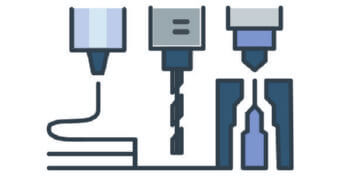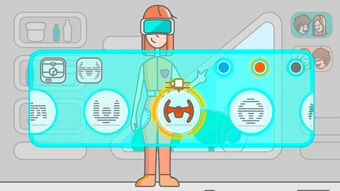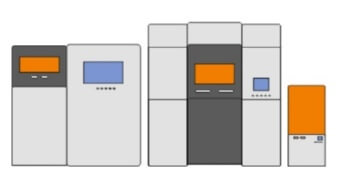The jewelry industry has been around for centuries, transforming materials such as metals, precious gems and even plastics into unique and artistic products. Tools used for producing jewelry have continued to change and evolve with the times and nowadays they can be made using a wide range of methods. For example, 3D printing not only allows for low-cost rapid prototyping, but also to produce finished products in metal. However, it seems to be CNC (which stands for Computer Numerical Control) technology that is making the biggest splash in the jewelry industry, offering a multitude of solutions to problems that modern jewelry makers are faced with today.
- How does a jeweler make a ring?
- How CNC machines help to create master models for casting?
- How CNC machines help to create molds?
- How CNC machines help to make end-use Jewelry?
- How CNC machines help to engrave jewelry?
- How CNC machines help marble faceting?
- How CNC machines help to work with metals?
- How CNC machines help to work with different materials?
- How CNC machines help to polish jewelry?
- What are the final thoughts on the use of CNC machining for jewelry?
How does a jeweler make a ring?
A common method to produce jewelry like rings and pendants is through metal casting, which consists of a number of technologies including lost wax casting. A wax model is made of an object which is then trapped inside a plaster block. Later, the plaster block is placed inside a kiln until the wax model evaporates. Next, the plaster mold is filled with liquid metal. Once the metal has cooled and hardened, the plaster is dissolved in water and you’re left with a metal copy of the wax model which is ready for post-processing.
Experienced jewelers are capable of making wax master models by hand using numerous carving tools with great precision and accuracy. However, it can be time-consuming and human error inherently leads to jewelry pieces being slightly different from one another if you consider that each new piece requires its own new wax model. In order to avoid this, wax models are created using another mold. Basically, the process of mass production requires creating a mold for wax master models and then new plaster molds for each piece casted with metal.
To make custom jewelry like wedding rings using traditional methods, the master would usually require somewhere between 2-4 weeks, with some companies even asking for at least 6-8 weeks to fully complete an engagement ring. This is where CNC machining really shines through, helping to save time and cut down the costs for creating a piece of jewelry.
How CNC machines help to create master models for casting?
Since metal casting is one of the most popular methods to create jewelry, manufacturers tend to focus on improving the process of making master models to speed things up. Instead of hand carving pieces from wax, makers use CNC machines. If a wax copy of a jewelry piece is created with CNC technology, it may allow more complex and precise geometries to be produced compared to a hand-carved piece. For example, engraved details can be done before casting. Machines also operate faster but they would require a CAD file of an object to be created.
To work the block of wax, several types of CNC machines can be used such as milling, turning and water jet. To remove material from intricate areas, a CNC machine should be equipped with a thin type of mill and if different types of surfaces required, the process would include switching tools for other sizes and angles. Depending on the number of axis a machine has, less tool changes needed and more possibilities are available but if a jeweler creates a specific type of object, they usually select the most suitable machine optimized for those.
The downside that mechanical milling, drilling and turning CNC machines may have for working castable wax blocks – the deformity of material. Since wax is quite a soft material, mechanical tools can accidentally heat it up during the process and warp some parts - especially in thin and intricate places. CNC machines that are fine-tuned for creating master models usually have special cooling systems which prevent the wax from crooking under a tool and delivers smooth surface finishes. Another type of CNC machine which is often used for carving master models is water jet. Water jet cutting is quite similar to milling but instead of mechanical mills, it operates with a flow of water mixed with abrasive materials. Water jet CNC machines don’t heat the piece of wax so much and no tooling changes are needed. If a water jet machine has many axis or a turning table, it can produce good results like that of milling machines.
How CNC machines help to create molds?
Some types of jewelry can be created without lost wax casting if a future part would consist of metals or materials with low-melting points. Since lost wax casting requires making several molds, using it for plastic, resins and some other materials that are used for making jewelry is not the best choice. Instead, a mold for cold casting plastics, metal powders or softer metals can be made.
CNC machines are able to make molds of many materials including steel. CAD design of a jewelry piece would be easily changed to a negative imprint of the object in a block of material and a machine carves it. The method is cost-effective for creating molds for flat pieces or it can be improved to make a mold for other objects too. Depending on the material of the mold, almost all CNC machines can be used to produce one – from foam, metal, acrylics and much more. The extra advantage here is that stronger molds can be used several times.
How CNC machines help to make end-use Jewelry?
Modern machining centers or even specially constructed custom machines can operate without any casting processes at all. Equipped with tough milling tools and power supplies, they can create jewelry like rings, bracelets, pendants and earrings from a block of a material. Some of them are capable of working with precious metals like gold and silver – but to do so a machine needs to rotate tools with at least 30000-60000 rpm since those metals are soft. On top of reducing the costs and time required for metal casting, CNC machining jewelry from a material block has extra design advantages. Some milling machines are capable of creating a “puzzle effect” - when several pieces of an object look like they’re trapped within one another and can move a little bit in their cavity. Such an effect is impossible to achieve through metal casting and hard to copy using hand tools.
Various tools also offer to post-process a part all in one go – polish, tap, engrave and smooth the piece, so after machining it’s ready to go. For manufacturing a jewelry piece on a CNC machine from expensive material, it’s better to be equipped with a scrap recovery system to gather removed chips of metals for reuse.
How CNC machines help to engrave jewelry?
Engraving words or patterns plays a big role in the design aspect of jewelry. Metals or other materials can be engraved by hand or during the carving of a wax model, but CNC machines also help to take the process to the next level. There are various engraving operations CNC machines can process which allow to achieve different effects like:
- Simply milling a phrase, name or whatever one needs on a finished jewelry or wax model. Thin CNC mills can create sharp, visible and precise engravings.
- Matte surface or patterns – some laser engraving machines can engrave the surface of a metal to give it a matte appearance. It works great for creating an image or pattern as a design feature. On the other hand, the matte engraving can consist of tiny dots and lines with different intensity to transfer shadows, contours and depth of a picture.
- Deep engraving – this type of engraving helps to create a “popping up” effect on objects. Instead of removing material from cavities, a machine (like laser CNC) engraves the outer parts.
- Color engraving/marking – this engraving can be made by a laser as well. Usually, to add some color to an engraving, the part would require using acrylic powder or paints but some machines can make a colored engraving straight on the object in one go.
- Sub-surface engraving – this particular type of job is processed with CNC laser engravers only. The technology enables engraving not on the surface of an object but rather inside it. A program splits an image into dots and then a laser shoots quickly through a clear material, creating matte marks. These marks cause micro fractures in the crystal, which appear as bubbles, and finally build a whole image.
How CNC machines help marble faceting?
A lovely option for a jewelry maker is to mount a beautiful gemstone or even a bunch of them. But, anyone familiar with marbles would agree that the natural look of diamonds, ambers, rubies and other precious stones is...ugly. Or at least not what you expect – most of these gorgeous stones look like dirty rocks when found. To release their dazzling appearance, jewelers need to cut, facet and polish them. And the process is quite tiresome in some cases – for example, a “Portuguese cut” is a form with 117 facets.
Once a stone is inspected, it should be cut to a form and faceted – and the more faces it has, the longer the process is. It is crucial to make the faces precise and accurate, and each face type would require different cutting angles. The danger here is to overcut or deform a stone, and as some gemstones are expensive and even quite rare, the process requires a lot of experience. Companies that sell already finished gemstones and crystals to jewelry makers are required to deliver perfectly faced pieces as otherwise, they may not suit objects as planned.
On the market, there are some special CNC machines created for faceting marbles. They look like tools for manual faceting but the computer does all the control functions so the result is accurate. Faceting machines typically consist of a sanding wheel, which spins quickly and receives water, abrasive or special chemicals for improving the process, and a holder with a gemstone attached. Depending on the unit type, it can facet and polish one or many gemstones at once. Usually, the faceting machine would require a human to un-mount and turn the gemstone to facet it from all sides but all other work is left to the CNC machine. Industrial faceting units also monitor the progress in real time and show completed and processing faces in a computer screen for easier control.
How CNC machines help to work with metals?
Metals are popular materials to create jewelry with, and masters know how to make a plain sheet of metal more attractive. Giving metal a texture can be a small prefabricating step or the main decorative decision. The general idea is to create something special and interesting from a flat sheet of metal by giving it a certain pattern – holes, drawings, scratches, imprints.
Typically, metals are textured by using the hammering method or an embossing die but the ways are limitless if an idea is really out of the box. CNC machines can texture metals as well by all the same technologies that jewelers do manually. Patterns can vary according to a CAD drawing and machine’s specifications. Also, some CNC types like laser or plasma cutters can produce more possibilities than manual tools by creating color changes on metals. Despite the fact that there are lots of mass-produced embossing dies for jewelers on the market, a CNC machine can help making custom dies for pressing it into the metal later.
After metal is textured, it should be cut. If many similar pieces are needed, usually a pancake die is used. Compared to cutting with tools, a pancake die works great if you need many small pieces of simple forms with accurate edges. Pancake dies can be created in various ways but manufacturing with plasma cutters is generally cheaper.
How CNC machines help to work with different materials?
A huge variety of CNC tools is available on the market – almost every type of CNC machine can be different in power and axis capabilities, which allows working with many materials without damaging them. As an advantage, CNC machines can cut flexible, rubbery materials, leather and really tough and strong metals as well, which are difficult to carve by hand. Some jewelers go crazy with these machines and make jewelry from unexpected materials such as meteorites, carbon fiber, super-conductors and even old smartphones.
How CNC machines help to polish jewelry?
After a piece created, it requires post-processing work to achieve the final look. One of the post processing steps is polishing – this one is what gives jewelry its outstanding shine. Polishing jewelry manually is a routine, so masters usually use lathes to rotate a part for them during sanding and polishing. This method works fine if a part needs to be fully polished but CNC machines can go one step further and polish objects with various brushes and tools for different effects. They also can rotate a part to polish it only in some areas, leaving other areas intentionally untouched. Special brushes also help to satin the pieces and create a matte effect. Combining satin with polishing helps to create images, patterns and curves on jewelry pieces and play with shine and gloss.
What are the final thoughts on the use of CNC machining for jewelry?
The common advantages of using CNC machines are:
- Accuracy and precision, which are crucial if working with expensive materials and gemstones.
- Broader range of possibilities and materials, which empower design and creativity.
- Faster production achieved by introducing the appropriate CNC technology at certain steps of the production process.
- Less human resources involved in the job so jewelers can invest their time into design rather than long and laborious tasks.
- Quite easy operation of CNC machines. Modern units have smart software, which would just “eat” a CAD drawing and construct a program for the machine.
On the contrary, there are some limitations of CNC machines:
- Requires extra cooling systems to avoid material deformation.
- To cut some metals, a CNC machine should be powerful.
- Most lattice structures and hollow parts are impossible to create.
- For mechanical CNC machining various bits and mills need to be replaced as they wear, which can be expensive to purchase.
So to understand if a CNC machine is a good choice for a certain jewelry production, it’s required to analyze what steps are involved in the process, and what consumes the most time and money? This would give a clear idea on which operations can be automated with an advantage and what kind of CNC machines can help to optimize the entire production process.






